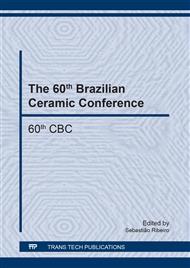p.21
p.27
p.33
p.39
p.44
p.50
p.55
p.60
p.65
Rice Husk Ash as a Raw Material to Produce Willemite Pigments
Abstract:
This study focuses in the synthesis of ceramic pigments based on the crystal structure of willemite (Zn2SiO4). The willemite obtained from the combination of commercial zinc oxide and rice husk ash is produced in a conventional ceramic process without the use of mineralizer agent and with the addition of cobalt oxide or nickel oxide as the source of chromophore ions. The synthesis temperature used was 1200°C. The characterization of pigments involves the use of X-ray diffraction and scanning electron microscopy. The pigments applied in matte enamel and sintered at 1100°C or 1200°C developed color between blue and beige. The construction of absorbance curves showed the color development behavior of each pigment. The results showed the possibility of obtaining willemite, from rice husk ash and the color development efficiency of the material, besides showing the interference of chromophore ion (Ni and Co) in color development.
Info:
Periodical:
Pages:
44-49
Citation:
Online since:
January 2018
Authors:
Keywords:
Price:
Сopyright:
© 2018 Trans Tech Publications Ltd. All Rights Reserved
Share:
Citation:


